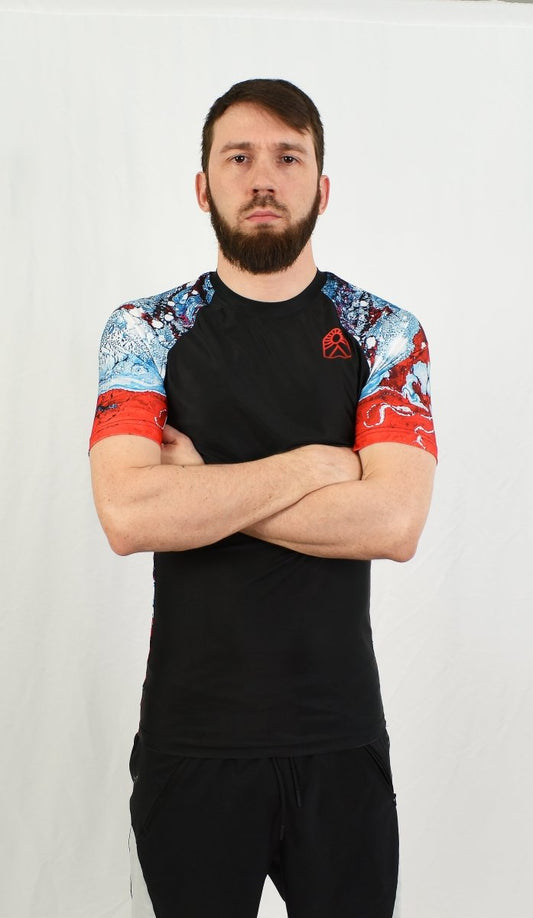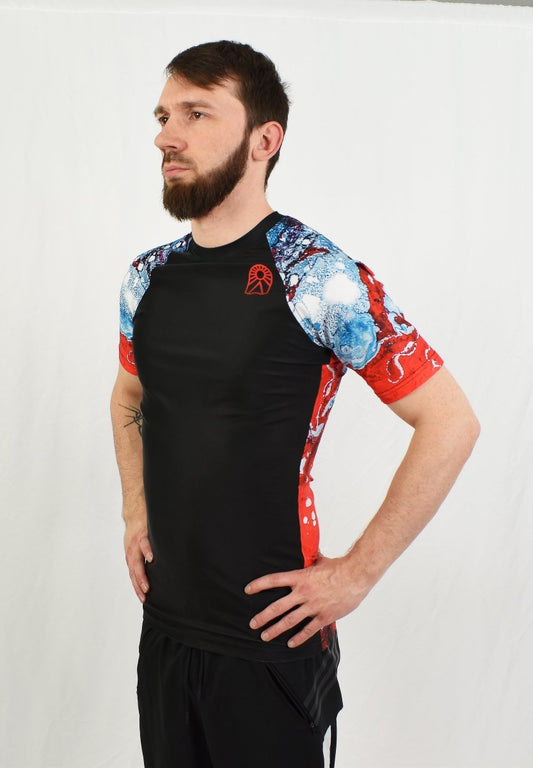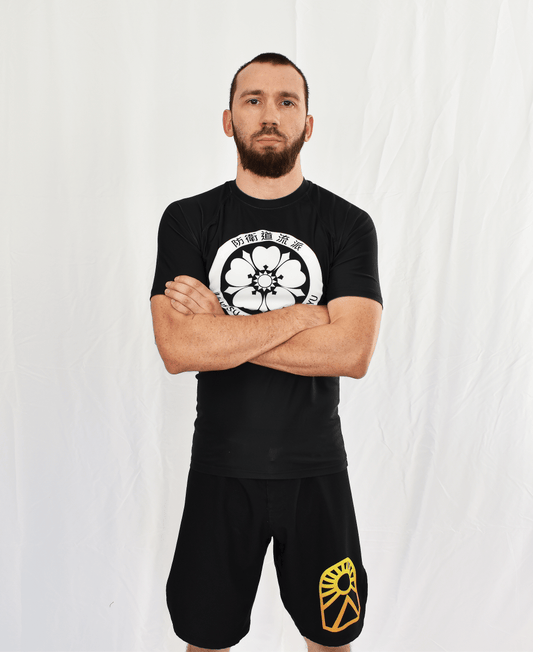
How long does it take to learn Jiu Jitsu?
Pascal CadoretteHave you started Jiu Jitsu? How long does it take to learn Jiu Jitsu?
So, you've taken the plunge and started taking Jiu Jitsu classes. You've just taken the hardest step of your entire journey: getting started.
Now that you've started, you've probably done a few rounds of flow, a few little sparring sessions here and there, tried a few techniques, only to be faced with the abysmal evidence of the beginning: you know absolutely nothing, don't know what to do when you're on the ground, and the course will be very difficult.
Don't panic, it's normal, we've all been there! I myself remember my early days in Jiu Jitsu when I was being bent over and strangled all over the place. Even when, as a man in his thirties, 16-year-olds were strangling me without any difficulty. My carotids took a beating and so did my ego.
But in concrete terms, how long does it take to learn Brazilian Jiu Jitsu?
In this comprehensive article, I take the time to share with you the learning journey of Brazilian Jiu Jitsu and how long you should expect to learn Brazilian Jiu Jitsu and progress.
Table of contents of the article
- What to Expect When Starting Brazilian Jiu Jitsu
- Starting as a white belt to intense sparring rounds
- Your goal as a white belt: survive
- The importance of training on the tatami
- How to train at home
- Frequently Asked Questions When Starting Out
What to Expect When Starting Brazilian Jiu Jitsu
If you want to dive into the details of everything you need to know to get started in Jiu Jitsu, I recommend the article everything you need to know to get started in Brazilian Jiu Jitsu . This way, you will have all the elements, in detail, on what you need to know to get started.
Initially, you should expect a learning path that will be long and winding. Jiu-jitsu is a sport that is extremely focused on learning from your mistakes, reflection and strategy. You will need to be patient, learn from your mistakes, know how to listen to instructions and ask questions to improve.
Your progress
The first thing I recommend to you from the beginning is to focus on your own journey. Don't compare yourself to others, because your learning can quickly become a nightmare and you didn't start doing Jiu Jitsu to stress yourself out. You started learning Jiu Jitsu to relax, enjoy the sport and have fun.
Everyone progresses at their own pace. Some people are great from day one, other people need more practice and that's totally okay.
This is your journey. This is your progression. You have your own challenges and other people have their own challenges.
The important thing is to try to learn and apply at least one thing in every class. Don't train for nothing. Focus on one aspect at a time and progress step by step. Gradually, over time, you will improve and develop your weapons and defenses.
Equipment needed to start in Jiu Jitsu
Fortunately, the good news is that you don't need a ton of equipment to get started in Jiu Jitsu. A few quality rash guards , a few pairs of grappling shorts and a mouthguard and you're well equipped to roll and learn!
Different types of Jiu Jitsu exist and require different types of equipment, but I have written a complete article on the subject: All the equipment needed in Brazilian Jiu Jitsu
If you want to train at home to speed up your Jiu Jitsu learning, then I recommend a grappling dummy or any other wrestling dummy. Don't forget a good mattress for the floor and you are well equipped to train.
Starting as a white belt to intense sparring rounds
Of course, when you start out, you all want to jump into the action, spar and dive into the intensity. But first, you need to understand the basics and etiquette. Jumping headfirst into sparring without knowing the basics can be dangerous for you, but also for your training partners.
So it's important to know what to do and how to do it before you start. Of course, any good school will teach you these basics before you get into intense sparring with other gym members.
However, I am sharing with you my learnings, drawn from my experience when I started.
Tap, even when you think you can "get through it"
Leave your ego at the door. At many times you will be tempted not to "hit" because you think you can get away with it or because you don't want to lose face in front of your teammates.
Here's what's going to happen:
- You will lose consciousness.
- You're going to get hurt.
You are on the mat to train and learn. There is no room for ego, it is normal to tap, you are learning. Do not risk getting injured, just because you want to keep your ego intact. If you do it out of ego, not only will your ego be broken, but your tendons too. When I started, I happened to do the same thing, I paid the price with persistent pain in my elbows and knees. This pain prevented me from training for several weeks and if you think your ego is scratched because you tapped, imagine the shame of having to say "I got injured because I didn't want to tap" . It's even worse. Put your ego aside.
Be careful of your partners with dangerous techniques
In the UFC, we often see spectacular techniques or movements to attack the opponent or get out of difficult positions. But be careful, do not always trust what you see in the context of competitive professional fights. The goal of fighting in the UFC is to hurt the opponent . Your goal on the mat and in training is to train and learn .
This is why sometimes when you start, you want to imitate what you see on TV or in videos: forward rolls when the opponent is on your back, slams, flying arm bars, etc. Be aware that some techniques can be dangerous for you and your teammates.
Communicate regularly with your teammates. Personally, this is what I do when I'm sparring. I prefer to hit and then ask questions about how I could have gotten out of it rather than panic and do whatever move I can.
Ride more quietly: Slow is Smooth, Smooth is Fast
At first, when you learn Jiu Jitsu and you want to go too fast, you can be dangerous for yourself, but you can also be dangerous for others. It can come from the intensity of sparring with your partner, but it can also come from a lack of knowledge of the field.
Take the time to take the time. I remember a piece of advice I heard in a class: Slow is Smooth, Smooth is Fast . Which simply means that taking the time to do the movements well, more slowly, will make your movements more fluid. If your movements are more fluid, you will be faster. There is no point in going fast, if your movements are not fluid, you will have to start over because you made a mistake or you risk injuring yourself or a training partner.
I remember a training partner I was riding with who was starting out at the same time as me. A guy a little bigger than me. Not very muscular, but very stiff and very nervous. The sparring was extremely intense with him because he exploded every time and tried to make the fastest submission. I'll let you imagine the explosive arm bars that it gave and the tension it put on the tendons of the elbows.
In these situations, just ask your partner to take it easier to avoid getting hurt. If that doesn't work, just change partners, because it's all about the injury. You don't go to Jiu Jitsu to get hurt, you go to learn and improve.
Your goal as a white belt: survive
It may sound a little weird to say, especially for someone new to Jiu Jitsu, but your main goal as a white belt will be to survive on the mat.
It is this ability to adapt to the opponent that will help you accelerate your learning of Jiu Jitsu. This is where the foundations are laid and the basis of your Jiu Jitsu will be developed; learning the basics of defense to survive and then being able to have good postures to attack.
Everyone wants to get on the mat, do Rear Naked Chokes or Arm Bars, but no one wants to learn how to defend themselves, frame, learn sweeps, etc. However, you can't attack if you can't get out of trouble.
For this section of the article, we will focus only on the white belt. We will not go into detail through all the belts, to do this, you can consult our article on all the colors of belts in Brazilian Jiu Jitsu.
The importance of training on the tatami
Surviving on the Tatami - It's not a joke
I will always remember my first day in Jiu Jitsu. I signed up for a trial class, I mentioned to my coach that I had never done one. To give me some sort of direction on what I should focus on as a beginner he told me: "right now, your goal is just to try to survive."
At first I laugh and nod, thinking he's making a little joke to highlight the difference in skills between the members already here and me who's just starting out. I laugh and answer him: "Yeah! Exactly! I'll try to survive!"
From the first rounds of sparring I understood that it was not a joke. I had to learn to survive! Of course, today with hindsight, I know that my partners were careful and went easy on me, but at the time I was completely in survival mode trying everything to survive on the tatami.
As the classes went on, I quickly understood that the goal of surviving for a belt is not a joke. In fact, it is a simple way of saying that the white belt must learn the basics:
- learn how to build a good defense,
- learn the basics of movement,
- learn the basics of good defense,
- learn how to escape from dominant positions,
- learn to sweep.
And so, by learning these basics and applying them, the white belt learns to "survive" on the tatami and get through it without submissions.
We quickly learn that it takes techniques
Right from the start, when you don't know anything about Jiu Jitsu, you do whatever you want. You try what you saw on TV, you try to fight as you think. But your opponent has a head start (if not 2 or 3) on us and you only get even more tangled up in his game.
You can't just do whatever you want, push, force, wiggle in all directions. When you find yourself under a mount or under side control , you quickly realize that it takes techniques to get out of it.
This is where the white belt must listen (as well as all the other belts), ask questions, practice their escapes, and collaborate with their training partners to progress. It is this research of techniques and the refinement of these techniques that will allow you to progress in Jiu Jiutsu.
Building good defenses
As a white belt, your main goal is not to learn how to perform spectacular submissions and learn how to do Rear Naked Chokes right away. It is to start having good defenses to survive, move around and know how to control the game.
When you have a good defense and you are able to get out of unpleasant situations, then it will be time to learn how to position yourself to make attacks.
The very first defense I learned when I started in Jiu Jitsu, was the good old closed guard . A position that, for me, works very well since I have long legs and a good hip game to control, push, attract my opponent. I noticed that it is a defense in which I am very comfortable and my morphology helps me to be good. From this position, I learned to control my opponent and then the different sweeps that come with it.
Then, I learned the half-guard and all the possibilities that came with it, the possible sweeps . Finally, over the course of sparring and flow rounds, I learned to ask questions and find some escapes to get out of the mounts, notably with a Knee Elbow Escape which is the one I use most often.
Understand what a frame is and the opportunity it gives you
The very first line of defense that one must understand and integrate is a good frame. It is the foundation of defense and the basis of all your movements. Frames are simply the space that you create with your arms, legs, and any other parts of your body to build a solid structure that prevents your opponent from advancing or sticking to you.
Frames are the basis for protecting yourself, but be careful, because an arm stretched too far can become a vulnerability for you and an opportunity for your opponent. It is therefore a whole aspect to practice well to build a good first line of reliable defense to allow you to then escape or sweep .
Enjoy Flow and Sparring
Flow and sparring is a great opportunity to test and improve "in real time" since you have the opportunity to practice the techniques you learned in class and improve against other opponents.
One thing is clear: in class we drill techniques and different methods to defend, attack, sweep, etc. In drills, generally, you practice and your opponent exerts little or no resistance to let you work. However, in reality when you are sparring, your opponent will defend himself and exert a lot of resistance. Sparring is an excellent way to adapt this learning to the real situation of an opponent who defends himself and who does not let himself be done.
Sparring is an excellent opportunity to progress, to learn to adapt your techniques and (above all) to remember your techniques in stressful situations!
Learn to breathe (and not hold your breath)
The first thing that comes to mind when I talk about sparring is learning to breathe. If you do 5 minute rounds with your partners, you will realize that the cardio can go extremely quickly.
One of the first factors is that many people hold their breath when sparring with their partners. This is a normal reflex, but it must be broken quickly since it is very detrimental to your cardio.
Learning to breathe also means learning to manage the pressure that is put on you when an opponent is in mount, side control or knee on belly and he applies a lot of pressure on you and it prevents you from breathing. By having good management of your breathing, you are able to stay calm and not give up due to lack of oxygen, but be able to function with slow and managed breathing.
Learn to stay calm and manage your energy
Staying calm and managing your energy is equally important. From the beginning in Jiu Jitsu or even when rolling with experienced partners, we tend to push a lot, use force, want to explode, force an incomplete submission, etc. Which means that we waste a lot of energy on useless positions.
Energy management is extremely important to be able to last over time, conserve energy for positions that require explosions and, above all, remain calm under pressure.
Focus on the techniques you have learned
Sparring is a great opportunity to practice the skills you've just learned. Often, at first, we tend to see sparring as competitions and an opportunity to "beat" our opponents and show that we're good. However, that's not what sparring is for.
Sparring is an opportunity to practice our techniques in a real situation. It is an opportunity to put into practice what the coach has taught us and to adapt our techniques to an opponent who is defending himself.
Every sparring session should have taught you something to help you develop and improve. Ask your training partners questions, try to recreate certain situations, try to get the most out of your training sessions to help you progress as best as possible.
How to train at home
Of course, you will want to train at home. I guarantee it and it may already be your situation, the first months and the first years, absolutely everything at home will be an opportunity to spend a jiu jitsu move.
- Your wife hugging you
- Your wife leaning her legs on you on the couch
- A friend who shakes your hand
- etc
I tell you: everyone around you will be grateful if you buy you a grappling dummy or find you a training partner outside of the gym!
In short, you will most certainly want to train at home and it will be very beneficial.
Beware of YouTube and Instagram
Don't get me wrong, YouTube and Instagram are great platforms to learn and grow your Jiu Jitsu skills. However, like anything, it can get overwhelming.
Soon your Instagram feed and YouTube feed will become all about Jiu Jitsu tips, techniques, submissions and it just becomes too much. You can't learn everything and a lot of that advice can be detrimental to your learning and development.
Don't lose sight of your goals, what you need to improve at your stage and according to your skills.
Training with a Grappling Dummy
I bought a grappling dummy a few months ago and for me it has been a great investment! I don't regret getting a training dummy at all. I am someone who has a slow learning style and is very kinesthetic. I need to touch, feel the movement, break it down and repeat the movement many times before it is well imprinted in my memory. Having a grappling dummy helps me a lot to do these repetitions at home.
Not only that, but with the grappling dummy , you can repeat a specific move as you wish. You can work on your defense, your escapes , your sweeps , etc.
Of course, it's not perfect, the grappling dummy doesn't defend itself or offer resistance, but it's already an excellent start to acquire a movement and be able to remember it in real situations.
I highly recommend.
Training alone or with a friend
There are still some workouts that you can do alone at home. These will generally be movements like:
- granby rolls ,
- shots ,
- sprawls ,
- shrimps ,
- rolls ,
- bridges ,
- etc.
This type of training that is more focused on mobility and movement is still excellent to practice. These workouts will help you develop your mobility and agility on the tatami and improve your skills more quickly.
Frequently asked questions when starting out:
- Question: Will I get beaten up a lot in sparring when I first start out?
- Answer: Absolutely! It’s part of the process and, honestly, it’s how you learn the fastest. It gives you the opportunity to ask questions, try things and adapt. Honestly? It makes the progression even more enjoyable!
- Question: What equipment do I need to get started?
- Answer: A simple quality rashguard and a pair of grappling shorts and you are well equipped. Some people also use a mouthguard .
- Question: Is jiu-jitsu effective for self-defense?
- Answer: I fundamentally believe so. It's not 100% of Jiu Jitsu that will be, but a good knowledge of takedowns, pressure, escapes and mounts is definitely helpful for self defense.
- Question: How often should I exercise?
- Answer: As often as possible, as long as it remains enjoyable for you. Training should remain a quality time and a time that you enjoy. If you want to compete, then I recommend at least 2 to 3 times per week to really see an improvement. If you do Jiu Jitsu for fitness, for self-defense or simply to stay in shape, then train at least 1 to 2 times per week while following a pace that suits you.









